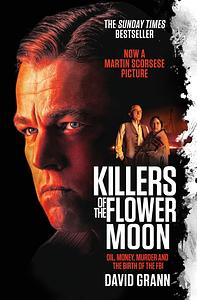Take a photo of a barcode or cover
14.4k reviews for:
Killers of the Flower Moon: The Osage Murders and the Birth of the FBI
David Grann
14.4k reviews for:
Killers of the Flower Moon: The Osage Murders and the Birth of the FBI
David Grann
dark
emotional
mysterious
reflective
tense
slow-paced
David Grann brings a brutal, shameful, and often overlooked chapter of American history to the forefront in Killers of the Flower Moon. Based on the true story of the “Reign of Terror” against the Osage Nation in the 1920s, this book is a powerful example of what happens when racial prejudice operates on a systemic level.
In the 1920s, the Osage people of Oklahoma were among the wealthiest individuals in the world per capita, due to oil reserves discovered beneath their land. However, entrenched racism within the U.S. government led many Osage to be placed under restrictive conservatorships, denying them control over their own wealth. Amid this injustice, a series of targeted murders began to unfold. Though the Osage sought legal help, they were frequently ignored or dismissed due to institutional prejudice. This lack of meaningful investigation allowed the killing spree to continue for years.
The book is divided into three parts: the first focuses on the Osage and the murders themselves; the second covers the investigation and trial; and the third explores the broader aftermath and lasting legacy of the “Reign of Terror.” This structure offers a comprehensive view of the people, places, and events surrounding the killings - and their enduring impact on the Osage Nation today. The result is a narrative that is horrifying, fascinating, and historically significant.
A secondary thread in the book is the formation of the Federal Bureau of Investigation. Although the FBI's origins predate the Osage murders, this case played a pivotal role in elevating the bureau’s national profile and shaping it into the agency it would become. Even with the FBI’s eventual involvement, the investigation remained riddled with complications and corruption - a reality explored in detail in the book’s second section.
Grann’s reporting is meticulous. At times, the large cast of real-life figures can feel overwhelming, and the scope of the case can lead to some confusion as the book progresses. But that complexity is warranted. Grann leaves no stone unturned, and while it may require some rereading or backtracking, the detail is essential to capturing the full scope of what happened.
Overall, Killers of the Flower Moon is deeply compelling, emotionally wrenching, and filled with twists and revelations rarely seen in nonfiction. It’s a must-read for anyone interested in American history, justice, and the consequences of institutionalized racism.
In the 1920s, the Osage people of Oklahoma were among the wealthiest individuals in the world per capita, due to oil reserves discovered beneath their land. However, entrenched racism within the U.S. government led many Osage to be placed under restrictive conservatorships, denying them control over their own wealth. Amid this injustice, a series of targeted murders began to unfold. Though the Osage sought legal help, they were frequently ignored or dismissed due to institutional prejudice. This lack of meaningful investigation allowed the killing spree to continue for years.
The book is divided into three parts: the first focuses on the Osage and the murders themselves; the second covers the investigation and trial; and the third explores the broader aftermath and lasting legacy of the “Reign of Terror.” This structure offers a comprehensive view of the people, places, and events surrounding the killings - and their enduring impact on the Osage Nation today. The result is a narrative that is horrifying, fascinating, and historically significant.
A secondary thread in the book is the formation of the Federal Bureau of Investigation. Although the FBI's origins predate the Osage murders, this case played a pivotal role in elevating the bureau’s national profile and shaping it into the agency it would become. Even with the FBI’s eventual involvement, the investigation remained riddled with complications and corruption - a reality explored in detail in the book’s second section.
Grann’s reporting is meticulous. At times, the large cast of real-life figures can feel overwhelming, and the scope of the case can lead to some confusion as the book progresses. But that complexity is warranted. Grann leaves no stone unturned, and while it may require some rereading or backtracking, the detail is essential to capturing the full scope of what happened.
Overall, Killers of the Flower Moon is deeply compelling, emotionally wrenching, and filled with twists and revelations rarely seen in nonfiction. It’s a must-read for anyone interested in American history, justice, and the consequences of institutionalized racism.
Graphic: Death, Gun violence, Hate crime, Racism, Toxic relationship, Violence, Grief, Medical trauma, Murder, Colonisation
Minor: Child death, Suicidal thoughts
This is a historic true crime novel. The victims of the crime were all Native American.
dark
informative
mysterious
tense
medium-paced
This is an excellent but grim read. Highly recommended.
informative
medium-paced
dark
informative
mysterious
sad
medium-paced
dark
informative
tense
medium-paced
informative
sad
fast-paced
dark
mysterious
reflective
fast-paced
fast-paced
challenging
dark
informative
mysterious
sad
tense
medium-paced
